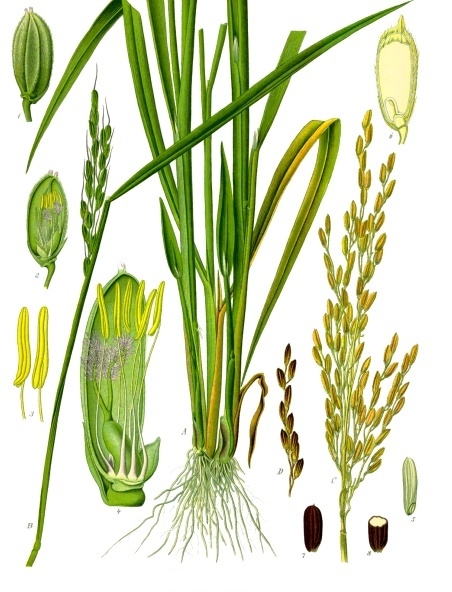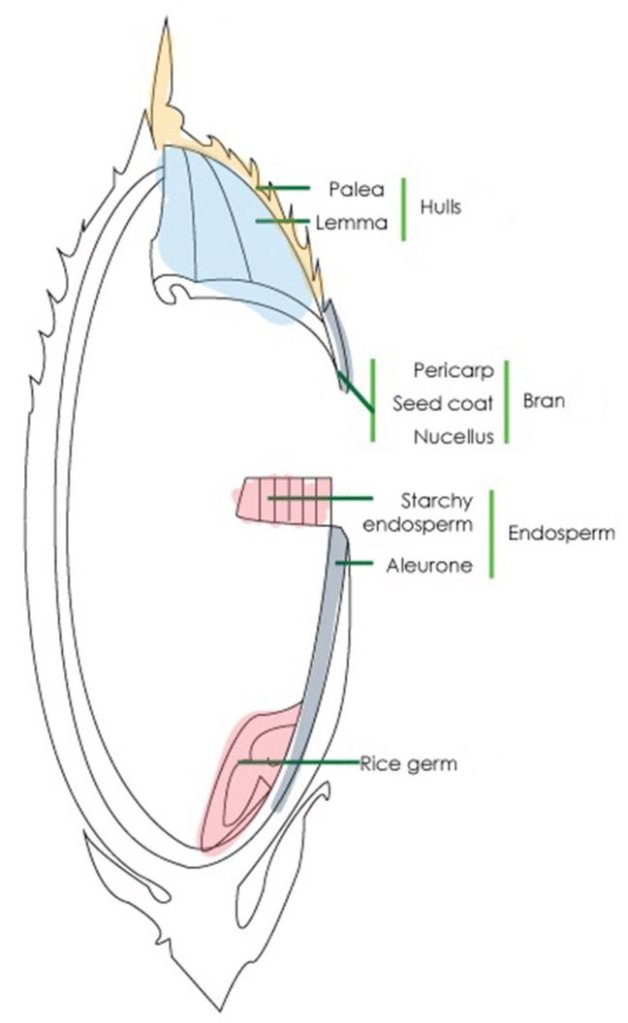
This image showing parts of the rice plant is from Köhler’s Medizinal-Pflanzen by Franz Eugen Köhler, and is in the public domain.
When I was a lad, I’d only heard of white rice*, in dessert form, as rice pudding. And, as ambrosial a treat as it no doubt was, that was usually out of a tin. I didn’t became aware of brown rice until I was much older. Anyway, having now done some research for this post, I realise that there exist several different colours of rice – not all of them necessarily ‘good’. So, by way of setting the scene for a consideration of the pink rice engineered by Sohyeon Park et al. (Matter 7: 1–22, 2024; https://doi.org/10.1016/j.matt.2024.01.01), here’s a flavour of what I uncovered about coloured rice.
Black rice: Also known as ‘forbidden rice’ because it was not to be eaten by anybody but the Emperor of China, hence its other name of ‘emperor’s rice’ (Miri Rotkovitz). The raw, uncooked grains look black due to presence of the pigment anthocyanin (Miri Rotkovitz; Tetsuo Oikawa et al., The Plant Cell 27: 2401–2414, 2015; https://doi.org/10.1105/tpc.15.00310).
Purple rice: The cooked or soaked grains of black rice look purple, and purple rice is apparently a synonym (Matt Ellis) for black rice.
Blue rice: Unlike the other coloured rice considered above it is essentially ‘dyed’. Its blueness comes from cooking white rice with flower-petals of Clitoria ternatea (butterfly-pea) (Swati Chatervedi; Sandra Marine Fernandes).
Yellow rice** is another dyed rice you can create by adding turmeric to the water wilst cooking white rice (Meghan; Swasthi Shreekanth) [the same colouring effect can be achieved by using the considerably-more-expensive spice saffron (Tori Avey; Rini). [Mr Cuttings wonders, would cooking white rice with both butterfly pea flowers and turmeric give you green rice, Cốm? There is, apparently, a rice that’s jade green.]
Red rice takes rice colour variation ‘to the next level’. Most of the other colour variants mentioned in this post are versions of Oryza sativa . The family of red rices includes: Oryza glaberrima (African red rice); Oryza longistaminata (‘red rice’); Oryza punctata (‘red rice’); and Oryza rufipogon (‘wild rice’ or ‘red rice’). As for black rice, the colour is due to anthocyanin. And, as for many other rices, consumption of red rice is associated with claims of various health benefits (Rajeev Singh).
Brown rice*** is the commonest colour of rice that’s had little processing before it’s cooked and eaten. For context here, a short diversion to consider the structure of the rice grain is appropriate.

Structure of a whole grain of rice (amended slightly from Rahele Panahabadi et al. (2021). Front. Plant Sci. 12:665745; doi: 10.3389/fpls.2021.665745).
The outer part of the rice flower consists of scale-like structures called the lemma, and the palea. When the rice ‘seed’**** has developed, those scale-like parts constitute what is called the ‘hull’, or ‘husk’ (Qiankun Xu et al. (2020). Sci China Life Sci 63, https://doi.org/10.1007/s11427-020-1816-x). The hull is considered indigestible by humans and is removed in rice grain processing. The de-hulled – or de-husked – rice is known as brown rice.
Further processing removes the bran (which is made up of several layers such as the pericarp and seed coat, and which may or not also include aleurone tissue) – that surrounds the white, starch-enriched endosperm – and the so-called ‘germ’ (the embryo of the rice grain that would normally develop into a new rice plant) that resides within the endosperm. The endosperm – with or without aleurone tissue – that remains after further processing is white rice (which may or not actually be white depending on what pigments it contains – as considered above with such variants as black and pink rice).
All of which polychromatic peregrination brings us back to a consideration of pink rice. A long-established pink-coloured rice is matta rice, whose grains are yellowish pink with reddish outer layers as a result of their being parboiled before they are used in cooking. Matta rice retains its pink hue after cooking. Like black rice in China, it was considered a royal food during the times of the Chera and Chola kingdoms in India (Jagran Josh). Properly-prepared matta rice dishes are safe to eat.
However, another well-known type of pink rice – but one which is to be avoided – is that which has been contaminated with microbes. Such rice is not to be consumed by humans and should instead be disposed of. [And, the same advice applies to cooked white rice in the refrigerator that’s gone blue or purple…].
The latest ‘pink rice’ (Roselyne Min) is not one that occurs naturally in cultivation or in the wild, or becomes coloured during cooking, or is microbe-contaminated. This pink rice has been created in the laboratory by Sohyeon Park et al. (Matter 7: 1–22, 2024; https://doi.org/10.1016/j.matt.2024.01.01), which work is admirably summarised in the title to their scientific paper, “Rice grains integrated with animal cells: A shortcut to a sustainable food system”.
An equally user-friendly, and understandable explanation of the work accompanies the paper’s ‘graphical abstract’, thus “A novel food ingredient that can overcome humanity’s food crisis has been created. Rice grains, a common food ingredient, are coated with gelatin (Grace Hussain)***** and food enzymes to become a home for cells that can contain many animal cells. Bovine muscle cells and fat cells grow and organize on the surface and inside the rice grain. This product is reminiscent of microbeef sushi (Christie Wilcox) and has a different texture, nutritional profile, and flavor than traditional rice grains”.
Whilst that pretty much sums-up what was done******, why was the work undertaken in the first place? What is driving this project? One major reason for investigating this hybrid animal-plant food is concerns around climate change/global warming. As Park et al. discuss, production of beef generates approx. 8 times more CO2 than for rice. Since CO2 is a major greenhouse gas contributing to global warming, that’s a big difference, and a considerable saving in farming rice [although, does that comparison factor-in any differences due to production of the even-more-atmosphere-warming, greenhouse gas methane, CH4, produced by both cattle (Amy Quinton), and rice (Aniruddha Ghosal)..?]. And the CO2 saving is likely to be real because it’s not beef from cattle that’s used in production of this so-called ‘microbeef sushi’, but beef cells that have been cultured in a laboratory.
Another incentive for the work is an economic one. Considering this, Park et al. (2024) optimistically conclude that the 4.8 g of a kilogram of the hybrid rice that is ‘beef cells’ adds only three US cents to the kilo cost of non-hybrid rice. Paying such a very small ‘premium’ to have a food that delivers not only lots of calorie-generating carbohydrates (from the rice component), but also other important food groups such as protein and fat (from the beef) is something that “will undoubtedly improve the nutritional content of hybrid rice” (Park et al., 2024). In the researchers’ own words, “the birth of hybrid rice can significantly reduce the problem of CO2 generation and reach consumers with reasonable nutrition and price”. It will be interesting to see how this work progresses, and whether there will be consumer demand for this hybrid food.
* But if you think that uncoloured, white rice is uninteresting and bland, think again. There’s far more to rice than its colour – for example qualities such as how the grain looks, smells, and tastes, and how it physically feels from the first bite to the final gulp – as considered in the article by Kenji Hall at the ever-interesting Gastro Obscura section of the Atlas Obscura site.
** Quite unrelated to yellow rice, although a colour variant of some importance is golden rice. In this case, the colour comes from beta carotene that the rice has been genetically-modified to produce. Also known as provitamin A, beta-carotene is a plant pigment that the human body converts into vitamin A as needed. The goal of the work was to produce rice that could be widely grown in southeast Asia, where vitamin A deficiency is a major healthy issue. For more on that story, see articles by Ed Regis, and Michael Le Page.
*** Not all rice that is brown in colour is actually brown rice. In particular, ‘dirty rice’, which may be brown isn’t really a colour of rice, it’s just an indication that the rice has been cooked with other foods and flavourings such as meat and spices. Its brownness makes it look ‘dirty’.
**** Which is technically not a seed, but a type of fruit known as a caryopsis…
***** The gelatin used by Park et al. (2024) was sourced from fish. If that news makes you concerned that your beefy rice dish will taste of fish – which you might not want – ‘t’ain’t so. Park et al. state that the “fish gelatin coating on the rice grains breaks down slowly during cell differentiation processes and can be completely removed by cooking heat”. Which presumably means no fishy taste to spoil your enjoyment of the meal.
****** For more scicomm items on this story, see here, Ian Sample, Christie Wilcox, Kelly Kasulis Cho, David Landsel, Shelly Fan, and (Roselyne Min). And for an audio discussion of the work, there’s a recording here.

Leave a comment